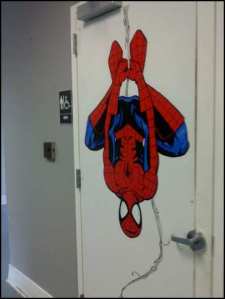My final project for e-Humanities and Social Science Reference is collection development for graphic novels and graphic arts. This morning I met with the librarian at The Kubert School to see what is like to develop a collection entirely of comics, graphic novels, and figure study books. I also wanted to gain a better understanding of the materials. My final project is more along the lines of collection development for public and academic libraries that want to integrate more of this medium into their collection, but I wasn’t going to pass on the opportunity to check out a comic library.
Don’t get me wrong — the library was small. The Kubert School is housed in one half of the former Dover High School, so the library is tiny…but mighty. A lot of the collection is donated by the school’s faculty and the Kubert family (as most work in the industry and receive comics from their respective titles), but there is a wealth of materials. The library circulates graphic novels, figure study books, single-issues and DVDs to their student body (70-80 students) and faculty for study and recreational purposes.
From a technical perspective, observing this library was fascinating since there is no elaborate circulation system in place. If a student wants to check an item out, them simply tell the librarian what they are checking-out and their name and the librarian marks it on that day’s log (transcribing it later into Excel for the return due date). If a student is interested in a specific item, the librarian checks the library’s holdings on Library Thing. Each item in the library is numbered numerically and in subject categories depending upon whether they are reference books (for figure study) or single-issues or graphic novels. This deeply fascinated me considering my background with integrated circulation systems, online catalogs, and security tags. What do you mean none of the books have bar codes on them? How do you keep track of things?
Well, if an item comes up for due, the librarian can simply walk down the hall of the classrooms and “confront” the student. No need for fancy gadgetry or spending money on elaborate mechanics. It was important for me to see this flexibility and adaptability in management. It shows how the librarian studied his target population and found a way to serve them efficiently but also organize the library instead of imposing a difficult, unusable system.
The students at the Kubert School are very serious about their craft and do not mess around when it comes to any part of it. The library does not operate on the honor system per say, but it operates on a system of respect and trust. Students are welcome to spend any amount of their day in the library, even when they should be in one of their classes. Although the school is housed in a former high school, the librarian treats the students as the adults that they are and there exists an equilibrium of professionalism and casualness about the library.
My favorite part of the library were the drawings. The librarian has students hang what work they want to display on the walls of the library. Most are 3rd year students, as they are the most far along in the program and the most developed, but there was some first-year work as well. First year or third year, it all looked incredible to me.
Before I left, the librarian had to show me the bathroom doors — librarians are funny people.



